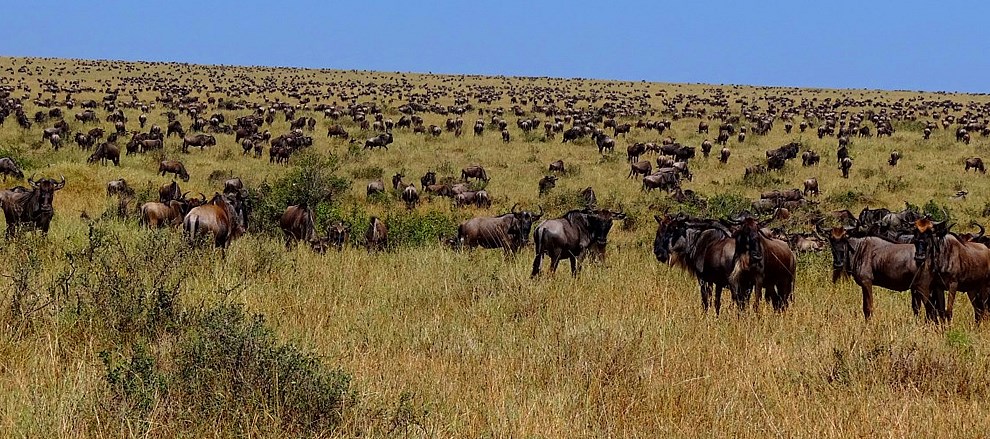

Serengeti Wildebeest migrations is the biggest mammal’s movement in the world, there is no real beginning or end to a wildebeest's journey. Its life is an endless pilgrimage, a constant search for food and water. The only beginning is at the moment of birth. An estimated 400,000 wildebeest calves are born during a six week period early each year - usually between late January and mid-March. From December to March every year, depending on the onset of the short and long rains, the southeastern Serengeti plains and the open woodlands around Lake Ndutu and Masek are transformed into a busy holding ground for vast herds of migratory animals, breeding and re-grouping in their hundreds of thousands before they start the long movements around May & June. The long rains, which start in mid March and continue on to the end of May, create a perfect habitat for the migratory animals, especially wildebeest and Zebra, to continue roaming in the Serengeti before they start fanning out. Ironically April and May, which fall within the low season, are also the quietest time of the year when the lodges are least congested and the hotel operators both in the game parks and beach locations, including Zanzibar, extend excellent price offers, often going as much as 75% lower than the peak months. Our cue is for you to take advantage of the excellent game viewing opportunities and the great value for money that this season is offering.
Between mid May and July, when drought sets in, Serengeti is the site of one of the most breathtaking events in the animal kingdom - the migration of thousands of wildebeest heading southwest, north or west in search of water and greener pastures. According to the Serengeti National Park official guide “Lines and columns of wildebeest up to 40 km long have been observed (from the air) heading southwest, north or west as the wildebeest trek to the woodland zone”. The migration lingers in the Western Corridor towards Lake Victoria area between June and July, and while Lobo area remains rich in wildlife during the dry months, most of the migratory animals move into Maasai Mara in Kenya by September. The migratory animals stay hardly three months in Maasai Mara, before streaming back into northern Tanzania in November. Serengeti was accepted by the World Heritage Convention as a World Heritage Site and Biosphere in 1981.
As of early July the bulk of the migration is still in Tanzania - along the western corridor / Musabi areas all the way to Grumeti. Large groups of wildebeest are also up in Lobo area. We would expect the herds to remain spread out until it dries out further (there is still a good amount of green grass and reliable water for the wildebeest and zebras).
In the month on August, the wildebeest have entered the Mara! The northern Serengeti national park personnel have reliably informed us that the migrating herds have taken two wings – one heading north from Grumeti area to the west, while an eastern wing is the one now moving into the Mara.
From September, the wildebeest are scattered throughout Tanzania's western corridor, northern Serengeti and Kenya's Maasai Mara. Travelers in both Kenya and Tanzania have been witnessing wildebeest crossing the Mara River!
From mid November, the wildebeest are back in the Serengeti and are moving south arriving at Ndutu Area around mid December. Elyon Tours is proud to its local safari guides who are best wildlife spotter and knowledgeable. Your safari with us will definitely last you with ever memories